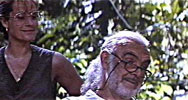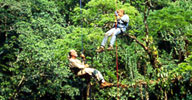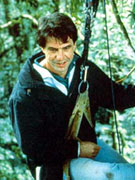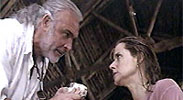
MICHAEL P. DAVIS

MICHAEL P. DAVIS
(Storyboard Artist )
03/07/01
"John
McTiernan is the only director that I've worked for
who I felt could command an army!"
"I don't remember how they found me, but I got a call from the production
company, asking me if I could leave the next day for the jungles of Mexico!
McT had already started shooting and they needed someone to board the fire in
the jungle sequence, and the wires in tree scenes.
I kind of got stuck in a weird politic: the producers needed storyboards to budget this fire sequence; but McT's head was into directing and really didn't have any time to focus on doing the fire sequence. I have now directed 4 features to date [NOTE: See Michael Davis' filmo at IMDB] and I know once you're in production, a director really can't focus on plotting things out with the storyboard artist. Anyway, I needed McT to tell me what to draw. Because he didn't have time, I had to follow him everywhere, to his trailer, at lunch time, wait for the end of shooting... But he was always too exhausted to get me going. The producers were upset that I hadn't drawn anything, so I told them: "How could I draw McT's vision if he didn't have the time or energy to talk to me?".

The production illustrator from Mexico had too much of a classical illustration style to create the drawings in Connery's character's sketch books, so McT had me draw lots of sketches in sketch books, to be used as props. He even thought Connery's character would draw on anything, like leaves... So I drew hundreds of drawings--mostly of the natives, a few of Lorraine Bracco--on hundreds (literally) of leaves! He told me to draw with ink and sticks, as if I really was Connery, stuck in the jungle, with very few art supplies. Many of my drawings ended up in the film. I'd say half of the burned drawings in the book were mine... But I think McT just had me do them just to stop pestering him about doing the jungle fire scene!
Finally, I did get some time with him, to work on the jungle fire scene... He had me draw out the general scope of the action, but not every detail, because I think he didn't want to paint himself into the corner with the producers, by documenting everything he wanted too early. I think he did not lean heavily on storyboards, which surprised me. There were a couple scenes with wires, and one where a character is hanging from the tree, but he didn't have me draw much coverage... He just had me draw the basic angles, so that the stunt guys could rig it. The forest fire was just the general action too. I think he creates his strong visuals on the set. The stuff in Connery's "bungalow" was created by tying a bungee cord to the camera for support, and using the bungee like a crude steadicam.

The meetings were not long, but McT was very concise and very specific. He's the only director that I've worked for who I felt could command an army! He is a true, strong leader that commands respect with his knowledge and specific vision. The meetings were short... Some of them were at the end of long days. But he was kind. He even took time to watch my student film and offered to make some introductions for me! The few talks we had were often around meals, with his then wife, Donna Dubrow. I only worked on the film for two weeks... Which was fine, especially since McT didn't have much time for me and the producers were breathing down my neck to finish!
The boards were for the crew and the producers. Most directors don't show the boards to actors, because the actors want to feel like the director is focusing on performance, not technical stuff or visual style.
My boards were black and white pen drawings. I try to give a sense in my boards if that a long lense or wide angle lense might look good... but the Director of Photography is far wiser about lenses that us lowly storyboard artists! The lense is also often dictated by how much room you have on set... You can tell from my boards what lense I was thinking about when drawing a panel, but I never specify in writing the focal length.
Also, my boards are detailed, but not real detailed. On a STAR WARS or SPFX shot, you need more details. My style is more about angles and editing... Most boards artists do 20 boards a day (with great details); I average 50 boards a day (although I was doing 100 a day on TEENAGE MUTANT NINJA TURTLES!). Storyboards are about experiments: they often are revised and revised. So, there is no need to draw super detail because, most of the time, the drawing is going to change several times.

McT seemed to express his vision just enough to his crew. Half the time, when other directors talk about vision, it is just artsy fartsy bs that never ends up on screen. McT is into the "less is more." He doesn't say much, but when he does, people listen. Most of the crew had worked with him before and love him. They know what he wants from having worked on several films with him... So there is no need for him to say much.
On some films, I study directors style, but I didn't have time with MEDICINE MAN: I was on a plane to Mexico 24 hours after being called!
Yes, storyboards can often work as writing--when I did JACK FROST for Warner, most of the toboggan chase gags and jokes and set pieces were ideas that I storyboarded, and weren't in the script. But, on MEDICINE MAN, I only drew what was in the script. [As a storyboard artist,] I was not what you call the "first director of the film", I was just a tool... On other films, I've "directed on paper" more, but not on MEDICINE MAN.
On other shows, photos and set sketches are helpful. On this show, I was on location, so I got to see many of the intended sets. But a jungle is not as specific as the layout of a building, so my boards were more general. McT shot MEDICINE MAN in the same area as he shot PREDATOR. Much of the rainforests in the world had been cut down... He was so disappointed in the scouts of the other rainforests, he decided to return to Mexico!

There was a funny moment on set, when the rain machine had moisturized Lorraine Bracco's hair, to the point that she was always asking before a shot: "How's my hair?". Connery busted the crew up by imitating Lorraine and asking before a shot: "How's my hair?".
I loved the film [MEDICINE MAN]. Directing is so, so hard, and stressful... When I was younger and inexperienced, I used to say "Oh, I could have done that scene better!", but now that I've directed four films myself, I never think that! Because the direction of a film is built on so many intangibles, how much time and money you have, are you behind schedule, etc... Watching a film, you don't know what the director went through to get something on film. So, it is backstreet driving to think I could do it better... I wish I had the presence and leadership and aura of a "general" that McT has on the set when I direct! Maybe that will come in time, when I have more success and more notices for my films. I really admire McT."
©
2002 - The John
McTiernan Central.